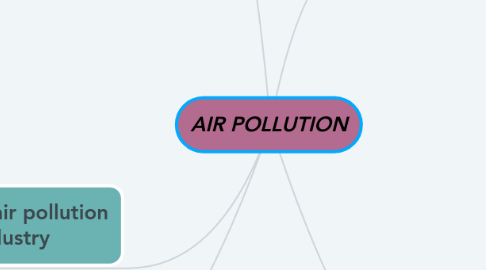AIR POLLUTION
afiqah Yusriにより

1. Composition of air pollution from oil palm industry
1.1. Nitrogen - 78% Oxygen - 20.6% Other - 1.4%
1.2. These react with nitrogen oxides (NOX) in the presence of sunlight to form ozone
1.3. Oil palm trees produce unusually high levels of so-called volatile organic compounds (VOCs).
2. Type of air pollution from oil palm industry
2.1. The opening of oil palm plantations by burning will create smoke pollution, increase in air temperature, and climate change. As a result of the opening of oil palm plantation land by burning in Sumatra and Kalimantan has caused the export of fog to Malaysia and Singapore. This fog will greatly affect health and daily activities, such as transportation disruption,
3. Effect air polution
3.1. Plant
3.1.1. Decreased growth rate and increased death rate.
3.2. Animal
3.2.1. Formation of the acid rain in the air damages fish life in lakes and streams
3.3. Belongings
3.3.1. H2SO4, acid react with limestone, marble and other building materials to cause deterioration.
3.4. Human
3.4.1. - Asthma - Cancer risk
4. history of air pollution in Malaysia
4.1. Air pollution has been an ongoing problem in many countries in the Southeast Asia region, and Malaysia is one of the worst affected.
4.2. The main cause of this haze is the slash and burn practice by farmers and peat fires blown by the wind from Indonesia. Especially Sumatra, which mainly affects the Peninsular Malaysia and Kalimantan, which mainly affects East Malaysia. A state of emergency was announced once in 2005 at Port Klang as the Air Pollution Index (API) went above the 500 level.
4.3. Malaysia is working with the Indonesian authorities to help curb peat fires. Malaysia and Indonesia, together with other members of the ASEAN community, signed the ASEAN Agreement on Transboundary Haze Pollution in 2002 as a result of a 1997 haze. However, Indonesia is the only country that has not signed the agreement. A repeat incident in 2005 and 2006 has forced Malaysia and Singapore to pressure Indonesia to sign it
5. Good ozone vs Bad ozone
5.1. Ozone occurs in two layers of the atmosphere. The layer surrounding the earth's surface is the troposphere. Here, ground-level or "bad" ozone is an air pollutant that damages human health, vegetation, and many common materials. It is a key ingredient of urban smog. The troposphere extends to a level about 10 miles up, where it meets the second layer, the stratosphere. The stratospheric or "good" ozone layer extends upward from about 10 to 30 miles and protects life on earth from the sun's harmful ultraviolet rays (UV-b)
5.2. Good Ozone: Occurs naturally in the upper atmosphere of the Earth and is also known as stratospheric ozone. Here, it forms protective shields which protect us from sun's harmful UV radiations. Due to various manmade chemicals it is partially destroyed and causes hole in the ozone.
5.3. Bad Ozone: It is ground level ozone which is not directly emitted into the air and is known as Tropospheric ozone. It is generated by the chemical reactions of nitrogen oxides and volatile organic compounds (VOC). This happens when the pollutants are emitted by cars, power plants, industrial boilers; chemical plants etc. and these chemicals react in the presence of sunlight. Do you know that at ground level it is harmful air pollutant because it effects in people and the environment and also is the main ingredient in smog? In urban areas on hot sunny days ozone reaches to unhealthy levels and can reach high levels during cold weather. Now, you may be thinking that in rural areas this ozone reaches or not? Yes at rural areas also ground level ozone transported by the wind and can experience high ozone levels.


